Master Your Achar: Avoiding Common Mistakes in Pickling for Perfect HomemadeGoodness

Homemade achar holds a cherished spot in Indian kitchens, celebrated for its tangy, spicy delight. Whether passed down through generations or customized with a personal twist, the joy of pickling is undeniable.
Yet, many face disappointment—mushy textures, mold growth, or bland flavours. This blog uncovers common mistakes in pickling and offers clear, actionable solutions. These insights help you master the art and science of preserving food, whether for home use or online sale. Pickling requires precision and care. From ingredients to technique, every detail matters when aiming for perfect homemade achar.
The Foundation – Ingredients & Ratios

Let’s take cucumber pickling as an example: the errors encountered during pickling are generally the same across all types of pickles.
Getting Your Ingredients Right: Salt, Oil, and Cucumber Choices
Successful pickling begins with the right foundation, selecting small cucumbers, high-quality mustard or sesame oil, and the correct salt ratio using coarse sea salt or pickling salt.
Oil Selection – The Preservative Power
Mistake: Using refined or light oils, skipping the smoking process, or choosing oils with low smoke points can reduce shelf life and alter flavour.
Fix: For authentic taste and preservation, always use mustard oil or sesame oil. Heat the oil until it smokes then let it cool before mixing it into your homemade achar whether it is mango, amla, or any other pickles.
Salt Precision – More Than Just Taste
Mistake: Incorrect salt ratios lead to spoilage or overly salty pickles. Using table salt with iodine or anti-caking agents causes cloudiness and discoloration.
Fix: Use 80–100 grams of salt per kilogram of produce. Choose coarse sea salt, pickling salt, or canning salt for clarity and effective moisture extraction. Accurate measurement and even distribution are critical.
Choosing Your Produce – The Perfect Base
Mistake: Using oversized cucumbers or poorly grown varieties results in watery or hollow pickles.
Fix: For crunchy pickle, select small and firm cucumbers from pickling-specific varieties. Process them within 24 hours of harvest, as even one day at room temperature can lead to hollow-centered or shrivelled pickles. If not possible, refrigerate or store in a cool, ventilated area to retain quality.
The Environment – Hygiene & Storage

Purity and Preservation: Moisture, Hygiene, and Storage Essentials for Long-Lasting
Pickles
Maintaining hygiene in pickling and ensuring proper storage—through sun-drying, sterilized jars, and glass jars with airtight lids are essential for to avoid common mistakes in pickling and preserve your achar for the long term.
Moisture and Contamination – The Enemy of Pickles
Mistake: Even minimal moisture invites bacteria and mold. Improper cleaning or drying of jars, ingredients, or utensils can compromise hygiene in pickling.
Fix: Sun-dry ingredients thoroughly before use. Sterilize glass jars and lids by boiling or sun drying. Always handle with dry hands and spoons, especially for online-ready pickles because hygiene in pickling plays a vital role for longevity.
Storage Savvy – Protecting Your Culinary Creation
Mistake: Using plastic containers, loose lids, or storing in damp, warm places. Opening jars before the flavours mature.
Fix: Use sterilized glass or ceramic jars with airtight lids. Store pickles in cool, dark areas. Use only clean, dry spoons for serving. Let pickles cure fully before consumption to develop rich flavours.
The Flavour Profile – Spices & Techniques

Spice Secrets and Culinary Science: Achieving the Perfect Taste and Texture in Every Batch
Achieving the perfect texture and flavour in every batch of achar relies on mastering spice balance, using dry-roasted spices, and applying the right firming agents while avoiding common mistakes in pickling.
Spice Perfection – The Soul of Achar
Mistake: Using stale spices or ground blends, skipping dry roasting, and allowing one spice to dominate can produce bitter or unbalanced flavours. Overcooking spices in brine also leads to discoloration.
Fix: Use freshly ground, dry-roasted spices to get the aroma and depth. Follow trusted recipes and use whole spices to retain clarity and flavour.
Brine, Texture, and Troubleshooting – The Science of Pickling
Mistake: Too strong or too weak salt/vinegar solutions, overcooking brine, or enzymes from cucumber blossoms can ruin texture.
Fix: Measure brine ingredients accurately. Trim 1/16 inch from cucumber blossom ends to remove softening enzymes. For firmness, soak cucumbers in ice water for 4–5 hours before pickling.
Firming Agents
Fresh produce rarely needs additives, but if used, calcium chloride for Pickle Crisp and it safely enhances crunch without changing acidity. Use food-grade calcium hydroxide for pickling lime only with proper rinsing to avoid health risks. Alum is no longer advised due to ingestion concerns. Grape leaves can also help inhibit softening enzymes.
Avoiding Off-Colors
Mineral-heavy water, iodized salt, or metal utensils can darken pickles. In addition, overripe or sunburned cucumbers can look dull. Use soft water, non-iodized salt, and stainless steel or heat-safe glassware for best results.
Your Journey to Pickle Perfection Starts Now!
Perfect homemade pickle success begins with avoiding these common mistakes in pickling. Apply these pickling tips for better results—whether preparing achar for your family, health, or as a product for online sale.
Remember, your perfect homemade achar is just a few fixes away! Choose Vebka Foods for delicious homemade kerala achar options. Let these inspire your next flavourful creation.




